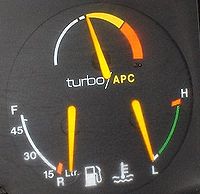
Automatic Performance Control
Encyclopedia
Automatic Performance Control (APC) was the first engine knock and boost control system that was introduced on turbo charged Saab H engine
s in 1982 and was fitted to all subsequent 900 Turbos through 1993 (and 1994 convertibles), as well as 9000 Turbos through 1989.
 The APC allowed a higher compression ratio
The APC allowed a higher compression ratio
(initially, 8.5:1 as opposed to 7.2:1, and, on 16-valve variants introduced in 1985, 9.0:1). This improved fuel economy
and allowed the use of low-octane petrol without causing engine damage caused by knock
.
The APC serves two purposes: it controls boost pressure - specifically, the rate of rise and maximum boost level - and it detects and manages harmful knock events.
To control the turbocharger, the APC monitors the engine's RPM
and inlet manifold
pressure
via a pressure transducer
, and uses these inputs to control a solenoid valve that trims the rate of rise of pressure as well as the maximum pressure by directing boost pressure to the turbocharger's pneumatic wastegate actuator.
To detect knock, a piezoelectric knock sensor
(basically a microphone
) bolted to the engine block responds to unique frequencies caused by engine knock. The sensor generates a small voltage that is sent to the electronic control unit
, which processes the signal to determine if, in fact, knock is occurring. If it is, then the control unit activates a solenoid valve that directs boost pressure to the turbocharger's pneumatically controlled wastegate
actuator, which opens the wastegate to bypass exhaust gases from the turbocharger directly to the exhaust pipe, lowering turbo boost pressure until the knock subsides. Knock events that are managed by the APC can be "seen" when the in-dash boost needle "twitches" slightly. The APC unit has a 'knock' output where an LED
may be connected. This LED will then light up if knock is detected. The pictured APC gauge has this custom LED fitted at the end of the red scale. Because the knock sensor becomes less accurate at high revolutions, the APC tapers maximum boost pressure after approximately 4,500 RPM.
 Saab Full Pressure Turbo (FPT) models with this unit include the APC name displayed on a non-numeric boost pressure gauge in the instrument panel. Although knock sensors are common even on non-turbocharged engines today, Saab has continued to use the APC name prominently as a differentiating feature.
Saab Full Pressure Turbo (FPT) models with this unit include the APC name displayed on a non-numeric boost pressure gauge in the instrument panel. Although knock sensors are common even on non-turbocharged engines today, Saab has continued to use the APC name prominently as a differentiating feature.
The white area on the left side of the scale shows manifold vacuum
under normal driving conditions, the short white dash is atmospheric pressure (engine off), the orange scale is where there is safe turbo boost, the red scale is boost above 0.5 - 0.7 bar
where the wastegate may be opened or a fuel cut due to knocking may occur.
Saab integrated the APC's boost control functionality with ignition control in 1990 with the introduction of the DI/APC system, available in 9000 models only. The DI/APC system managed knock not only by decreasing boost via a solenoid but by retarding ignition timing
as well; DI/APC also managed the engine's basic ignition timing.
Saab H engine
The Saab H engine is a redesign of the Saab B engine. Despite the name it is not an H engine, but a slanted inline-4. The H engine was introduced in 1981 in the Saab 900 and was also used in the Saab 99 from 1982 onwards and the Saab 90. It continued in use in the 900/9-3, 9000, and 9-5...
s in 1982 and was fitted to all subsequent 900 Turbos through 1993 (and 1994 convertibles), as well as 9000 Turbos through 1989.

Compression ratio
The 'compression ratio' of an internal-combustion engine or external combustion engine is a value that represents the ratio of the volume of its combustion chamber from its largest capacity to its smallest capacity...
(initially, 8.5:1 as opposed to 7.2:1, and, on 16-valve variants introduced in 1985, 9.0:1). This improved fuel economy
Fuel economy in automobiles
Fuel usage in automobiles refers to the fuel efficiency relationship between distance traveled by an automobile and the amount of fuel consumed....
and allowed the use of low-octane petrol without causing engine damage caused by knock
Engine knocking
Knocking in spark-ignition internal combustion engines occurs when combustion of the air/fuel mixture in the cylinder starts off correctly in response to ignition by the spark plug, but one or more pockets of air/fuel mixture explode outside the envelope of the normal combustion front.The...
.
The APC serves two purposes: it controls boost pressure - specifically, the rate of rise and maximum boost level - and it detects and manages harmful knock events.
To control the turbocharger, the APC monitors the engine's RPM
Revolutions per minute
Revolutions per minute is a measure of the frequency of a rotation. It annotates the number of full rotations completed in one minute around a fixed axis...
and inlet manifold
Inlet manifold
In automotive engineering, an inlet manifold or intake manifold is the part of an engine that supplies the fuel/air mixture to the cylinders...
pressure
Pressure
Pressure is the force per unit area applied in a direction perpendicular to the surface of an object. Gauge pressure is the pressure relative to the local atmospheric or ambient pressure.- Definition :...
via a pressure transducer
Transducer
A transducer is a device that converts one type of energy to another. Energy types include electrical, mechanical, electromagnetic , chemical, acoustic or thermal energy. While the term transducer commonly implies the use of a sensor/detector, any device which converts energy can be considered a...
, and uses these inputs to control a solenoid valve that trims the rate of rise of pressure as well as the maximum pressure by directing boost pressure to the turbocharger's pneumatic wastegate actuator.
To detect knock, a piezoelectric knock sensor
Sensor
A sensor is a device that measures a physical quantity and converts it into a signal which can be read by an observer or by an instrument. For example, a mercury-in-glass thermometer converts the measured temperature into expansion and contraction of a liquid which can be read on a calibrated...
(basically a microphone
Microphone
A microphone is an acoustic-to-electric transducer or sensor that converts sound into an electrical signal. In 1877, Emile Berliner invented the first microphone used as a telephone voice transmitter...
) bolted to the engine block responds to unique frequencies caused by engine knock. The sensor generates a small voltage that is sent to the electronic control unit
Electronic control unit
In automotive electronics, electronic control unit is a generic term for any embedded system that controls one or more of the electrical systems or subsystems in a motor vehicle....
, which processes the signal to determine if, in fact, knock is occurring. If it is, then the control unit activates a solenoid valve that directs boost pressure to the turbocharger's pneumatically controlled wastegate
Wastegate
A wastegate is a valve that diverts exhaust gases away from the turbine wheel in a turbocharged engine system. Diversion of exhaust gases regulates the turbine speed, which in turn regulates the rotating speed of the compressor. The primary function of the wastegate is to regulate the maximum boost...
actuator, which opens the wastegate to bypass exhaust gases from the turbocharger directly to the exhaust pipe, lowering turbo boost pressure until the knock subsides. Knock events that are managed by the APC can be "seen" when the in-dash boost needle "twitches" slightly. The APC unit has a 'knock' output where an LED
LEd
LEd is a TeX/LaTeX editing software working under Microsoft Windows. It is a freeware product....
may be connected. This LED will then light up if knock is detected. The pictured APC gauge has this custom LED fitted at the end of the red scale. Because the knock sensor becomes less accurate at high revolutions, the APC tapers maximum boost pressure after approximately 4,500 RPM.
APC boost gauge

The white area on the left side of the scale shows manifold vacuum
Manifold vacuum
Manifold vacuum, or engine vacuum in an internal combustion engine is the difference in air pressure between the engine's intake manifold and Earth's atmosphere....
under normal driving conditions, the short white dash is atmospheric pressure (engine off), the orange scale is where there is safe turbo boost, the red scale is boost above 0.5 - 0.7 bar
Bar (unit)
The bar is a unit of pressure equal to 100 kilopascals, and roughly equal to the atmospheric pressure on Earth at sea level. Other units derived from the bar are the megabar , kilobar , decibar , centibar , and millibar...
where the wastegate may be opened or a fuel cut due to knocking may occur.
Saab integrated the APC's boost control functionality with ignition control in 1990 with the introduction of the DI/APC system, available in 9000 models only. The DI/APC system managed knock not only by decreasing boost via a solenoid but by retarding ignition timing
Ignition timing
Ignition timing, in a spark ignition internal combustion engine , is the process of setting the angle relative to piston position and crankshaft angular velocity that a spark will occur in the combustion chamber near the end of the compression stroke...
as well; DI/APC also managed the engine's basic ignition timing.

